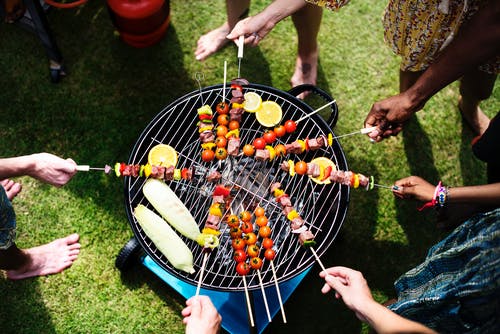While BBQ season may seem a long way off, preparation is key to achieve a safe BBQ. It is also timely to bring up memories of warmer days with the recent cold snap. The emotions evoked by the traditional kiwi barbeque are usually positive and positive emotions help lower stress. So, from this aspect, and also considering the benefits of the social gathering that are usually associated, BBQs could be considered as ‘healthy’ for us. Indeed, there is no denying these benefits but there are potential risks (aside from potential burns!) that need addressing to ensure the benefits outweigh the risks.
BBQing protein rich foods produces polycyclic aromatic hydrocarbons (PAHs), heterocyclic amines (HCAs), advanced glycation end (AGEs) products and acrylamide (AA). This is why it is much safer to BBQ fruits and vegetables as they contain very little protein.
PAHs, HCAs, AGEs and AA are released into the air and are also formed on the food item. Therefore, inhalation, skin absorption and gastrointestinal absorption are all significant routes of exposure, with consumption the major route, skin second, and inhalation third (1).
The health effects of exposure to these toxic chemicals vary but there is much overlap. PAHs and have been implicated in various human cancers including colon, lung and breast and in lab animals are highly carcinogenic (2). Similarly HCAs are also associated with increased risk of colon, lung, and breast cancer but also with liver, prostate, pancreas, and skin cancers (3). For AGEs, improved ‘primary and secondary health outcomes in humans’, have been shown in most studies, as a result of limiting AGE exposure (4, 5).
AA and its metabolite glycidamide (GA) have shown to have genotoxic and neurotoxic effects with the International Agency for Research on Cancer (IARC) classifying acrylamide as a ‘potentially carcinogenic substance to humans’ in 1994 (6). Although BBQ foods contain the highest amount of these toxic chemicals, AGEs and AA also appear in other foods. These include common staples like bread, potato products (e.g. chips and crisps), and coffee.
BBQing inside also leads to other airborne toxic pollutants including carbon monoxide, particulate matter, volatile organic compounds (VOCs) and carbonyl compounds). VOCs (e.g. benzene) can irritate your nose, throat and eyes; and can cause reduced coordination, nausea, and liver, kidney and neurological damage. Carbonyl compounds can cause respiratory tract irritation, mood swings, and eye and skin burns. In addition, some carbonyl compounds, e.g. acetaldehyde are linked to cancer (7,8).
To optimise BBQ safety (and also broiling, grilling and frying) food, to reduce exposure to these toxic chemicals try and implement as many of the following tips as you can:
- As some of the chemicals are caused when fat from the meat drips onto the BBQ heat source (which then attach to the food due to rising smoke and flames) use lean meat cuts.
- Use small meat, and fish portions as they cook faster and thus are exposed to the heat less. The easiest way to do this is to use skewers.
- Despite my husband the chef protesting at this one, the fact remains it helps! Precook the meat, or fish in the oven.
- Marinate the food before cooking. This reduces HCA formation of by around 94%. However, it is best to use low-fat or fat-free marinades (ideally homemade) to reduce fat from dripping on the heat source.5.
- If using coal fired BBQs, use low to medium temperature coals. If using gas fired BBQs then again select a low to medium heat.
- Frequently turning food can help reduce HCA formation. Again, this comes with a caveat. Try not to pierce the food which is easily achieved by using tongs or spatulas.
- Although roasting is safer than BBQing, broiling, grilling and frying, do not make gravy from the meat drippings.
Now you are well prepared for a much-needed summer BBQ!
- https://pubs.acs.org/doi/full/10.1021/acs.est.8b01689
- https://www.tandfonline.com/doi/abs/10.1080/10408398.2012.697497
- https://www.sciencedirect.com/science/article/pii/S0023643814003570
- https://www.sciencedirect.com/science/article/pii/S1568163718301193
- https://link.springer.com/chapter/10.1007/978-3-030-14654-2_1
- https://pdfs.semanticscholar.org/e1ad/775d9502d3fbf803302fb92cb2a6c380045b.pdf
- https://www.sciencedirect.com/science/article/pii/S0048969713003094
- https://www.sciencedirect.com/science/article/abs/pii/S0165993615002836

